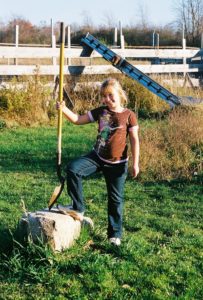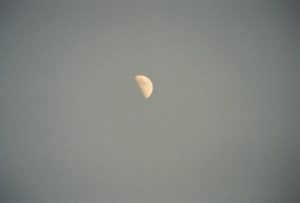Are you a Daylighter?
What country folks know to be common sense becomes news as a new practice in sustainability. Become a “daylighter” and put your lifestyle back in sync with the sun and the seasons. A daylighter wakes up with the sun and goes to sleep shortly after it sets.

Fishing in Warren Pond by dawn’s early light at. Photo by Jill Swenson
“Early to bed, early to rise, makes a man healthy, wealthy and wise,” wrote Benjamin Franklin more than two centuries ago. This wisdom seems self-evident to most farmers working their homesteads every day year round.
Twelve to 14 hours of sleep during the shortest days and seven to eight hours of shut-eye during the longest days of the year makes good sense for your own health and longevity and is an easy way to significantly lower your carbon-footprint.
The first reason to become a daylighter is to remedy sleep deprivation. Many Americans deprive themselves of sleep to the point where it is dangerous to drive, according to studies by the Federal Highway Administration, Turner-Fairbank Highway Research Center. Farmers are not immune from this problem. There is always more work to be done than hours in a day. Sleep exhaustion can lead to serious farm accidents.
Contrary to popular myth you cannot make up sleep you lost the night before, according to the National Sleep Foundation. Failing to get enough sleep heightens the risk for a variety of major illnesses, including cancer, heart disease, diabetes and obesity, according to findings from Harvard’s Nurses’ Health Study.

Great niece Jadyn up early for farm chores. Photo by Jill Swenson
Sleep is seasonal. In the cold winter months when the days are shorter we need to sleep more just like hibernating mammalians. Sleep is necessary to one’s overall health and in winter our bodies need to sleep more. In cold climates, sleep is the body’s way of conserving energy during winter. “As the day’s lengthen, the cold strengthens,” is a familiar weather observation for winter’s duration. The spring equinox brings an end to this winter jinx.
Sleep is the body’s restorative process. Sleep is very inexpensive preventative health care. It is when we are too tired that accidents happen, mistakes are made and we tax our immune systems. You know how much better you feel after a good night’s sleep.
The second reason to live by the sun’s clock is to decrease overall electric energy consumption. If you can live by daylight there is little use for electric lights. When electric power became widely available, it changed the way we farmed. With the passage of the Rural Electrification Act, electricity became available to country folks at the same price as city people paid. Night turned into day. Winter turned into summer and summer into winter. Electric power industrialized this nation. A “day” became three 8-hour shifts.
Before electricity when it got dark at night, people went to bed. There wasn’t much you could really do by candle light or oil lamps. Heating and refrigeration weren’t things you could take for granted without wood or ice. Before electricity, if you wanted to be warm in the middle of winter, you had to plan years in advance to have the seasoned wood on hand, dried and stacked, hours to start the fire and time to let the house get warmed and time for tending the wood fire. Today in upstate New York, this is still true if you heat or cook with wood.

When you live by the seasons, the sun, the moon and the stars, you fall into a natural rhythm of sleep and wakefulness. Photo by Jill Swenson
Before electricity you needed a root cellar to keep produce cool in summer and not freeze in the winter. Before electricity you had to harvest ice from the pond in the middle of winter and store it in a hay barn covered in sawdust for use four to six months later. You can still do this, and some country folk still do, however, most farmers have altered their practices significantly.
I grew up with the expectation of an electrified life. I assume at the flick of a switch there to be light, or heat, or sound, an image displayed or a door opened. All at the flick of a switch: On/Off. The binary code built the digital universe but it can’t power it. It runs on fossil fuels and is not sustainable. Daylighting offers a natural solution to soaring energy demands.
It sounds so simple and yet the practice of “daylighting” seems too extreme for many people who work long hours at one or more jobs, have children and family obligations, and cram their daily calendars well into dark. Daylighting doesn’t cost anything and will save you money, energy and years on your life, but most modern folks seem to resist this idea.
The rush and push and urgency of everyday life is not sustainable. Contemporary culture treats sleep as a waste of time. People have a hard time imaging what daylighting is like here on an upstate New York farm in the midst of winter when up to 14 hours of darkness constitutes a day. It’s easy in the summer when the birds start chirping before dawn around 5 a.m. and it’s still light after 9 p.m. These are the natural patterns of sleep according to the seasons of rural northeasterners.
Psychiatrist Thomas Wehr and his colleagues at the National Institute of Mental Health conducted a study in their sleep lab where they simulated the daylight hours of a winter day. Subjects went into the dark at 6 p.m. to lie down and rest. Lights did not come back on until 8 the next morning. Wehr was curious to see what might happen if he put busy modern Americans into the 19th century sleep environment.
Wehr’s sleep study found that the long night led to two bouts of deep concentrated sleep; two REM sessions with a period of wakefulness in the middle, lasting up to a few hours. Dr. Wehr’s study was published in the American Journal of Physiology.
Insomniacs might think lying awake for a couple hours in the middle of the night to be a kind of torture. But the subjects in the study described this period in terms used during the 1800s as a “watch” or “watching”; a period of heightened mindfulness.
There are historical records of people sleeping in first a “dead sleep” and later a “morning sleep” with the wakeful period between as a “watch,” according to the study’s lead investigator, Thomas Wehr. The subjects in his study reported this middle period as a kind of quiet meditation.
Researchers found similar results in a more recent study of adolescents. The longer night seems to give rise, according to National Public Radio correspondent Allison Aubrey in an August 2009 story, to a sort of “midnight comfort.” Teens grow so fast they need more sleep to catch up with their bodies.
A third reason to practice daylighting is that you will live longer and enjoy life so much more. Do you fight against sleep? Is your instinct to resist drowsiness? Do you push down the urge to close your eyes and rest? Give in to these urges. The more sleep you get, the less stress on your overall health and well being. Research from the Harvard Medical School found an increased risk of mortality among those who sleep less than six hours a night.
When you live by the seasons, the sun, the moon and the stars, you fall into a natural rhythm of sleep and wakefulness. The shortest days of the year come in the coldest months and the longest days during summer.
The simple act of “daylighting” doesn’t cost you anything. You don’t have to join a club or pass a test or buy anything to just do it. It sounds so simple and yet to practice it will make you a radical. Your friends and family won’t understand why you won’t attend evening events or answer the phone or email after dark. Your kids might think you are crazy, until their grades start improving and their attitude becomes more positive. The energy savings, increased work performance, improved health and sense of well-being provide positive reinforcements to the lifestyle changes.

